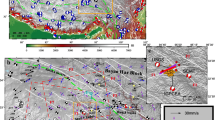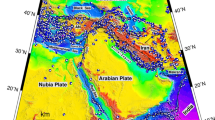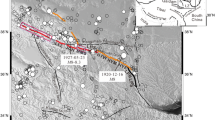Abstract
We describe crustal deformation associated with seismovolcanic events in the Izu Islands, central Japan that began at the end of June 2000; three faults were assumed and modeled for inversion analyses using GNSS data provided by the Geospatial Information Authority of Japan. After removing steps caused by antenna exchanges and coseismic steps associated with five large earthquakes, common mode errors, and a linear trend from the raw data, we divided the processed time series into five successive nearly equal 15-day time spans. As a first step, three fault models with homogeneous dislocations that best explained the observed GNSS data for the entire period were randomly searched for in an area where microearthquakes had occurred. As a result, the following three faults were identified: Fault 1, located to the northwest near Niijima; Fault 2, which extended from Miyakejima volcano to Kozushima northwestward; and Fault 3, located beneath Miyakejima volcano. As a second step, we divided Faults 2 and 3 into several subfaults with the same area to perform more detailed inversion analyses to estimate the spatiotemporal dislocation field on the three faults. The inversion results show that Fault 3 deflated by 0.57 km3, and the change in volume of Fault 2 was estimated to be 0.74 km3 by opening. Fault 1 slipped significantly right-lateral by 18.9 m, and the change in volume was estimated as 0.40 km3 by opening. Since the total increase in volume for Faults 1 and 2 was greater than 0.57 km3, which was the total deflation for Fault 3, a magma supply from greater depths to Faults 1 and 2 was required.











Similar content being viewed by others
References
Akaike, H. (1973). Information theory and an extension of the maximum likelihood principle, In Petrov, B. N. & Csádki, F. (Eds.), 2nd International Symposium on Information Theory, Tsahkadsor, Armenia, USSR, September 2-8, 1971 (pp. 267–281). Akadémiai Kiadó Budapest.
Akaike, H. (1980). Likelihood and the Bayes procedure, In Bernardo, J. M., DeGroot, M. H., Lindley, F. V. & A. F. M. Smith (Eds.), Bayesian Statistics (pp. 143–166). University Press Valencia.
Bird, P. (2003). An updated digital model of plate boundaries. Geochemistry, Geophysics, Geosystems, 4, 1027. https://doi.org/10.1029/2001gc000252
DeMets, C., Gordon, R. G., & Argus, D. F. (2010). Geologically current plate motions. Geophysical Journal International, 181(1), 1–80. https://doi.org/10.1111/j.1365-246X.2009.04491.x
Furuya, M., Okubo, S., Kimata, F., Miyajima, R., Meilano, I., Sun, W., Tanaka, Y., & Miyazaki, T. (2003). Mass budget of the magma flow in the 2000 volcano-seismic activity at Izu-islands, Japan. Earth Planet Space, 55(7), 375–385. https://doi.org/10.1186/bf03351771
Ito, T., & Yoshioka, S. (2002). A dike intrusion model in and around Miyakejima, Niijima and Kozushima in 2000. Tectonophysics, 359(1–2), 171–187. https://doi.org/10.1016/s0040-1951(02)00510-3
Japan Meteorological Agency (2001). https://www.data.jma.go.jp/svd/vois/data/tokyo/rovdm/Miyakejima_rovdm/miyakejima_2000.html
Kawamura, M., & Yamaoka, K. (2009). Temporal relationship between the 2000 Miyake-Kozu seismovolcanic activity and the 2000 Tokai slow-slip event. Tectonophysics, 465, 45–59. https://doi.org/10.1016/j.tecto.2008.10.009
Miyazaki, S., Segall, P., McGuire, J. J., Kato, T., & Hatanaka, Y. (2006). Spatial and temporal evolution of stress and slip rate during the 2000 Tokai slow earthquake. Journal of Geophysical Research: Solid Earth, 111(B3), B03409. https://doi.org/10.1029/2004jb003426
Mogi, K. (1958). Relations between the eruptions of various volcanoes and the deformations of the ground surfaces around them. Bulletin. Earthquake Research Institute, University of Tokyo, 36, 99–134.
Murakami, R. (2001). Periodicity of Crustal Deformation Associated with Inflation of Izu-Oshima and Miyakejima (before 2000 Eruption) Volcanoes (in Japanese). In Abstract of the Volcanological Society of Japan 2001, Fall Meeting, vol. 2, pp. 25. https://doi.org/10.18940/vsj.2001.2.0_25.
Nakada, S., Nagai, M., Kaneko, T., Nozawa, A., & Suzuki-Kamata, K. (2005). Chronology and products of the 2000 eruption of Miyakejima Volcano, Japan. Bulletin of Volcanology, 67(3), 205–218. https://doi.org/10.1007/s00445-004-0404-4
Nakagawa, H., Toyofuku, T., Kotani, K., Miyahara, B., Iwashita, C., Kawamoto, S., Hatanaka, Y., Munekane, H., Ishimoto, M., Yutsudo, T., Ishikura, N., & Sugawara, Y. (2009). Development and validation of GEONET new analysis strategy (Version 4). Bulletin of the Geographical Survey Institute, 118, 1–8.
Nakamura, K. (1984). Distributions of flank craters of Miyake-jima volcano and the nature of the ambient crustal stress field. Volcanological Society of Japan, 29, S16–S23. (in Japanese with English abstract).
Nishimura, T., Ozawa, S., Murakami, M., Sagiya, T., Tada, T., Kaidzu, M., & Ukawa, M. (2001). Crustal deformation caused by magma migration in the northern Izu Islands, Japan. Geophysical Research Letters, 28(19), 3745–3748. https://doi.org/10.1029/2001gl013051
Okada, Y. (1992). Internal deformation due to shear and tensile faults in a half-space. Bulletin of the Seismological Society of America, 82(2), 1018–1040.
Okubo, S., Sun, W., Yoshino, T., Kondo, T., Amagi, J., Kiuchi, H., Koyama, Y., Ichikawa, R., & Sekido, M. (2002). Far-field deformation due to volcanic activity and earthquake swarm. Vistas for Geodesy in the New Millennium. https://doi.org/10.1007/978-3-662-04709-5_87
Ozawa, S., Miyazaki, S., Nishimura, T., Murakami, M., Kaidzu, M., Imakiire, T., & Ji, X. (2004). Creep, dike intrusion, and magma chamber deflation model for the 2000 Miyake eruption and the Izu islands earthquakes. Journal of Geophysical Research: Solid Earth, 109(B2), B02410. https://doi.org/10.1029/2003jb002601
Ozawa, S., Murakami, M., Kaidzu, M., Tada, T., Sagiya, T., Hatanaka, Y., Yarai, H., & Nishimura, T. (2002). Detection and monitoring of ongoing aseismic slip in the Tokai region, central Japan. Science, 298(5595), 1009–1012. https://doi.org/10.1126/science.1076780
Segall, P., Bürgmann, R., & Matthews, M. (2000). Time-dependent triggered afterslip following the 1989 Loma Prieta earthquake. Journal of Geophysical Research: Solid Earth, 105(B3), 5615–5634. https://doi.org/10.1029/1999jb900352
Segall, P., & Matthews, M. (1997). Time dependent inversion of geodetic data. Journal of Geophysical Research: Solid Earth, 102(B10), 22391–22409. https://doi.org/10.1029/97jb01795
Seno, T. (2005). Izu detachment hypothesis: A proposal of a unified cause for the Miyake-Kozu event and the Tokai slow event. Earth Planet Space, 57(10), 925–934. https://doi.org/10.1186/bf03351872
Takahashi, M. (1997). The structure of high level crustal magmatic plumbing systems beneath the Quaternary arc volcanoes in Japanese Islands. Volcanological Society of Japan, 42, S175–S187. (in Japanese with English abstract).
Wessel, P., & Smith, W. H. F. (1998). New, improved version of generic mapping tools released. Eos, Transactions of the American Geophysical Union, 79(47), 579. https://doi.org/10.1029/98eo00426
Yabuki, T., & Matsu’ura, M. (1992). Geodetic data inversion using a Bayesian information criterion for spatial distribution of fault slip. Geophysical Journal International, 109(2), 363–375. https://doi.org/10.1111/j.1365-246X.1992.tb00102.x
Yamaoka, K., Kawamura, M., Kimata, F., Fujii, N., & Kudo, T. (2005). Dike intrusion associated with the 2000 eruption of Miyakejima Volcano, Japan. Bulletin of Volcanology, 67(3), 231–242. https://doi.org/10.1007/s00445-004-0406-2
Acknowledgements
We thank Geospatial Information Authority of Japan and Japan Meteorological Agency for providing data of GNSS and hypocenter data, respectively. We also thank T. Yabuki for sharing his source code for an inversion analysis, and M. Matsu'ura for his constructive comment. All the figures were created using Generic Mapping Tools software (Wessel & Smith, 1998). This work was partly supported by JSPS KAKENHI grants 16H06477 and MEXT KAKENHI grant 21H05203.
Funding
This work was supported by Japan Society for the Promotion of Science(Grant number 16H06477 )
Author information
Authors and Affiliations
Corresponding author
Ethics declarations
Conflict of interest
The authors declare that they have no conflict of interest.
Additional information
Publisher's Note
Springer Nature remains neutral with regard to jurisdictional claims in published maps and institutional affiliations.
Supplementary Information
Below is the link to the electronic supplementary material.
Rights and permissions
About this article
Cite this article
Akiyama, T., Kawabata, H. & Yoshioka, S. Spatiotemporal Changes in Fault Displacements Associated with Seismovolcanic Events in and Around Miyakejima and Kozushima in 2000 Inferred from GNSS Data. Pure Appl. Geophys. 179, 4245–4265 (2022). https://doi.org/10.1007/s00024-022-03084-y
Received:
Revised:
Accepted:
Published:
Issue Date:
DOI: https://doi.org/10.1007/s00024-022-03084-y




